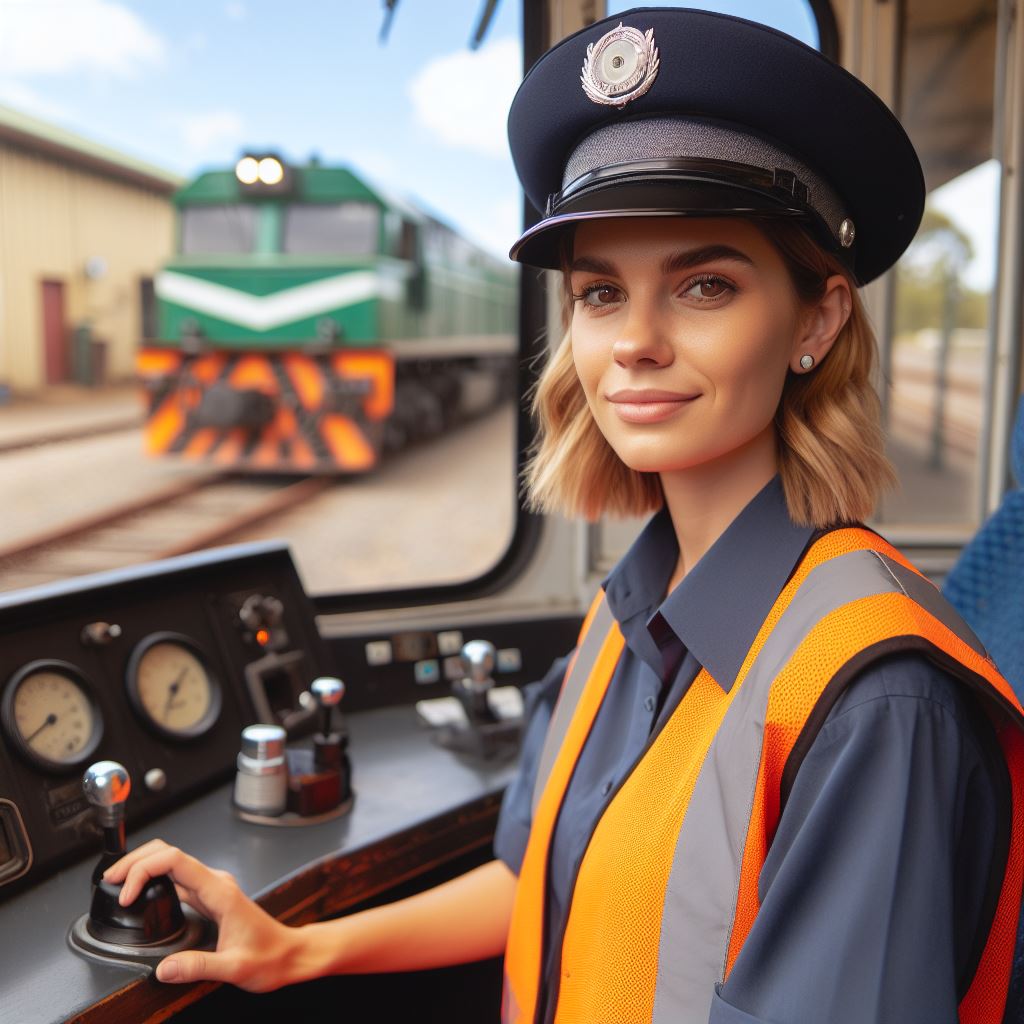Introduction
Welcome to our blog section focusing on the critical topic of train driver health and safety in Australia.
In this article, we’ll delve into the unique challenges and considerations faced by train drivers.
Operating trains comes with physical and mental demands, making health and safety paramount.
Australia’s vast railway network presents diverse environments and conditions, impacting driver well-being.
From long hours behind the controls to exposure to noise and vibration, train driving poses health risks.
Mental health is also a significant concern, given the pressures and responsibilities inherent in the role.
Ensuring the health and safety of train drivers is essential for the efficiency and reliability of transportation systems.
In this blog section, we’ll explore the measures and initiatives aimed at safeguarding train driver well-being.
From ergonomic cab designs to comprehensive training programs, various strategies address health and safety concerns.
We’ll also examine the importance of rest breaks, fatigue management, and mental health support for train drivers.
Additionally, we’ll discuss the role of technology in enhancing safety and reducing risks for train drivers.
Despite the challenges, being a train driver can be a rewarding career with proper support and resources.
By prioritizing health and safety, railway companies promote a culture of well-being and resilience among train drivers.
Join us as we dive into the complex and critical issue of train driver health and safety in Australia.
Overview of Train Driver Health & Safety
A. Physical and mental challenges faced by train drivers
Train drivers face various physical challenges such as long hours of sitting, irregular shifts, and exposure to noise and vibrations.
Your Personalized Career Strategy
Unlock your potential with tailored career consulting. Get clear, actionable steps designed for your success. Start now!
Get StartedThese can lead to musculoskeletal issues, fatigue, and a higher risk of accidents.
Additionally, train drivers experience mental challenges, including high levels of stress, concentration demands, and the responsibility of passenger safety.
These factors can contribute to mental health problems like anxiety and depression, which could impact overall well-being.
B. Potential risks and hazards associated with their job
Train drivers face a range of risks and hazards, such as potential collisions with other trains, vehicles, or pedestrians, as well as encountering obstacles on the tracks or dealing with mechanical failures and emergencies.
They must also navigate through diverse weather conditions, including heavy rain, fog, or extreme heat, which can affect visibility and track conditions.
Additionally, exposure to loud noises and vibrations poses risks to their hearing and overall well-being.
C. Importance of prioritizing health and safety in this profession
Prioritizing health and safety in the train driving profession is vital for numerous reasons.
Firstly, it ensures the well-being and longevity of train drivers, reducing the risk of physical and mental health issues.
Furthermore, prioritizing health and safety leads to enhanced job satisfaction, resulting in increased productivity and overall improved performance.
It also maintains public confidence and ensures a safe and reliable transportation system for passengers.
Additionally, adhering to health and safety protocols prevents accidents, injuries, and potential loss of life, safeguarding not only the train drivers themselves but also the passengers, other staff members, and the general public.
Legislative Framework and Regulations
A. Overview of Legislation and Regulations
- The legislation and regulations concerning train driver health and safety in Australia are crucial.
- The main legislation governing this area is the Rail Safety National Law (RSNL) and its regulations.
- The RSNL was enacted to ensure consistent safety standards across all rail networks in Australia.
- It applies to all rail transport operators, including train drivers, and aims to minimize risks.
- The Rail Safety National Law Regulation provides detailed requirements for health and safety management.
B. Role of Governing Bodies and Authorities
- Governing bodies and authorities play a vital role in enforcing safety standards for train drivers.
- The Office of the National Rail Safety Regulator (ONRSR) is the primary governing body responsible for overseeing rail safety.
- ONRSR works collaboratively with state and territory bodies to monitor compliance with regulations.
- It conducts audits, inspections, and investigations to ensure operators meet safety requirements.
- ONRSR has the authority to impose penalties and sanctions for non-compliance, prioritizing safety above all.
C. Guidelines and Protocols for Train Drivers
- Train drivers must follow a set of guidelines and protocols to ensure their safety and the safety of others.
- One of the key requirements is obtaining appropriate certification and licenses, demonstrating competency.
- Drivers must undergo mandatory health screening, including regular medical assessments and psychological evaluations.
- They must also receive thorough training on emergency procedures, hazards, and risk management.
- Train drivers are responsible for adhering to safe work practices, such as fatigue management and alcohol/drug restrictions.
- They should maintain constant communication with control centers and follow signaling systems and speed limits.
- Drivers must be vigilant and report any safety concerns, incidents, or hazards they encounter during their shifts.
- Regular maintenance and inspection of trains and equipment are essential for safe operations.
- Train drivers are encouraged to participate in ongoing training and professional development opportunities.
- Demonstrating teamwork and collaborating with other rail employees is crucial for maintaining a safe working environment.
Basically, the legislative framework and regulations surrounding train driver health and safety in Australia are comprehensive and vital.
The Rail Safety National Law (RSNL) and its regulations provide consistent safety standards for all rail transport operators.
The Office of the National Rail Safety Regulator (ONRSR) plays a crucial role in monitoring compliance and enforcing safety standards.
Train drivers must follow guidelines and protocols regarding certification, health screening, training, safe work practices, communication, reporting, maintenance, and teamwork.
By adhering to these requirements, train drivers can ensure their own safety and contribute to the overall safety of the rail network.
Health and Wellness Programs for Train Drivers
A. Initiatives and Programs to Promote Train Driver Health and Wellness
- Rail companies have implemented various initiatives and programs to prioritize the health and wellness of train drivers.
- These initiatives aim to address physical, mental, and emotional well-being through targeted interventions.
- Training programs are offered to train drivers to promote a healthy lifestyle and provide resources for maintaining overall well-being.
- Physical fitness programs help train drivers improve their strength, stamina, and flexibility, ensuring they are in optimum physical condition.
- Companies also organize workshops and seminars on stress management, sleep hygiene, and nutrition to support train drivers’ mental and emotional health.
- Supportive work environments that facilitate work-life balance and encourage self-care are fostered by rail companies.
- Flexibility in work schedules, family-friendly policies, and opportunities for rejuvenation during breaks are provided.
- Workspaces are designed ergonomically to minimize physical strain and reduce the risk of injuries.
B. Counseling and Support Services for Train Drivers’ Mental Well-being
- Train drivers have access to counseling services that help them cope with the psychological challenges of their demanding profession.
- Confidential support services are available, allowing train drivers to discuss their concerns, anxieties, and work-related stress.
- Professional counselors with experience in dealing with the unique issues faced by train drivers are readily available.
- These services aim to identify and address mental health issues early on to prevent chronic problems and promote resilience.
- Employee assistance programs are implemented to provide additional mental health support for train drivers and their families.
- These programs offer resources such as counseling, therapy, and educational materials, focusing on stress management techniques and positive coping strategies.
C. Importance of Regular Health Check-ups and Screenings
- Regular health check-ups and screenings are crucial for maintaining the overall well-being of train drivers.
- These assessments help identify health issues at an early stage, allowing for timely intervention and treatment.
- Physical examinations assess vital signs, fitness levels, and potential risk factors, ensuring train drivers are in good health.
- Screenings for conditions such as cardiovascular diseases, sleep disorders, and mental health concerns are provided.
- Early detection of health problems enables proactive measures and the provision of necessary support.
- Timely treatment and management of health issues contribute to the longevity of train drivers’ careers.
- Rail companies emphasize the importance of regular health check-ups and screenings through awareness campaigns and incentives.
- Educational materials and resources are provided to train drivers to enhance their knowledge about preventive health measures.
By prioritizing the health and wellness of train drivers, rail companies aim to create a safer and more sustainable industry for both employees and passengers.
Through initiatives and programs, supported by counseling services and regular health check-ups, train drivers can thrive in their profession and enhance their overall quality of life.
Stand Out with a Resume That Gets Results
Your career is worth more than a generic template. Let us craft a resume and cover letter that showcase your unique strengths and help you secure that dream job.
Get HiredRead: Salary Insights for Train Drivers in Oz

Training and Skill Development
A. Training requirements and qualifications necessary to become a train driver in Australia.
- Completion of a Certificate IV in Train Driving is the minimum requirement to become a train driver.
- Trainee drivers must also possess a current driver’s license and have good physical and mental health.
- Applicants need to pass aptitude tests, medical assessments, and undergo a rigorous interview process.
- Training programs include classroom instruction, on-the-job training, and practical driving experience.
- Trainee drivers must gain sufficient knowledge of railway policies, procedures, signaling systems, and emergency response protocols.
- They are also trained in operating various types of trains and equipment in different weather conditions.
B. Ongoing training and skill development opportunities available to train drivers.
- Train drivers are required to undergo regular refresher training to maintain their skills and knowledge.
- Refresher courses cover updates on safety regulations, railway rules, and the latest technology advancements.
- Simulation exercises provide train drivers with practical experience in handling emergency scenarios.
- Training programs offer opportunities to enhance communication, decision-making, and problem-solving skills.
- Continuous skill development ensures train drivers can effectively respond to various operational and safety challenges.
C. Significance of continuous learning and staying up-to-date with safety protocols.
Train driver health and safety relies on ongoing education, training, and staying informed about safety protocols:
- Changes in safety regulations require train drivers to stay updated to ensure compliance and minimize risks.
- Continuous learning enables train drivers to adapt to new technologies and evolving rail industry practices.
- Awareness of safety protocols helps train drivers identify hazards, mitigate risks, and prioritize passenger well-being.
- Continuous training improves situational awareness, ensuring better decision-making and response during emergencies.
- Staying up-to-date with safety protocols fosters a culture of safety among train drivers and promotes a positive work environment.
Therefore, becoming a train driver in Australia requires meeting specific qualifications, completing rigorous training, and gaining practical experience.
Ongoing training and skill development opportunities ensure train drivers stay competent, adaptable, and well-equipped to handle the complexities of their job.
Continuous learning and staying up-to-date with safety protocols are vital for a train driver’s health and safety, as well as for maintaining a safe and efficient railway system.
Read: Trucker Tales: Stories from the Road
You Might Also Like: Emergency Procedures: Training in Australia
Safety Measures and Technologies
A. Safety Measures Implemented on Trains and Rail Networks
- Train operators in Australia prioritize the safety of their train drivers by implementing various measures.
- Regular training programs are conducted to enhance the drivers’ skills and ensure they are up-to-date with safety protocols.
- Safety barriers, such as fencing and signage, are installed along rail networks to prevent unauthorized access.
- Train stations and platforms are equipped with high visibility markings and warning signs for both drivers and pedestrians.
- Speed restrictions are implemented in specific areas to minimize the risk of accidents and ensure safer journeys.
- Automatic Train Protection (ATP) systems are installed to control train speeds and maintain safe distances between trains.
- Advanced signaling systems, including interlocking mechanisms, are used to regulate train movements and prevent collisions.
- Emergency stop buttons and communication devices are available onboard for drivers to report any safety concerns or incidents.
- Regular safety audits are conducted to identify potential hazards and ensure compliance with safety standards.
- Train drivers are encouraged to report any safety issues they encounter, fostering a culture of open communication and continuous improvement.
B. Use of Modern Technologies to Enhance Safety
- Fatigue management systems are utilized to monitor train drivers’ fatigue levels and prevent accidents caused by exhaustion.
- These systems analyze various factors like the duration of work, breaks between shifts, and physiological data to determine fatigue levels.
- Surveillance cameras are installed both inside and outside train cabins to monitor driver activities and ensure compliance with safety regulations.
- These cameras act as a deterrent to potential misconduct and can provide crucial evidence in the event of an incident or accident.
- Telematics systems equipped with GPS technology allow supervisors to track the location and speed of trains in real-time.
- GPS-based systems also enable remote control and emergency intervention in case of any safety threats or abnormalities.
- Sensors and detectors are installed on trains to detect anomalies in temperature, pressure, and other equipment parameters.
- Remote diagnostic systems analyze the collected data to detect potential faults in trains and initiate timely maintenance actions.
- Collision avoidance systems, such as Automatic Train Control (ATC), use radar and other technologies to prevent train collisions.
- In-built sensors send signals to the ATC system, which automatically applies brakes or adjusts train speed to avoid accidents.
C. Importance of Proper Maintenance of Trains and Equipment
- Regular maintenance of trains and equipment is vital to ensure their safe and reliable operation.
- Scheduled inspections and maintenance routines are carried out to identify and address potential issues proactively.
- Proper lubrication of moving parts, replacement of worn-out components, and repairs are essential to prevent equipment failures.
- Thorough checks are conducted on braking systems, traction systems, signal systems, and other critical components.
- Compliance with manufacturer guidelines and industry standards is crucial to maintain the overall safety of trains.
- Routine maintenance also extends the lifespan of trains and helps in avoiding costly breakdowns or accidents caused by equipment failure.
- Maintenance personnel are trained to recognize and report any abnormalities or potential safety risks observed during their inspections.
- Collaborative efforts between train operators, manufacturers, and maintenance teams ensure effective maintenance practices.
- Feedback from train drivers regarding potential safety concerns or equipment malfunctions is highly valued.
- By prioritizing proper maintenance, train operators can ensure the safety of their train drivers, passengers, and the general public.
Read: Day in the Life of an Aussie Train Driver
See Related Content: Eco-Friendly Trucking in Australia
Challenges and Future Trends
A. Challenges Faced by Train Drivers in Maintaining their Health and Safety
- Long working hours and irregular schedules pose significant challenges for train drivers.
- The demanding nature of the job puts train drivers at risk of physical and mental health issues.
- Exposure to noise, vibration, and ergonomic challenges may lead to occupational health problems.
- Fatigue and sleep disorders are common among train drivers due to their work patterns.
- Managing stress and maintaining mental well-being is crucial for train drivers in their daily responsibilities.
- Train drivers face the challenge of maintaining a healthy diet and regular exercise amidst their demanding schedules.
- Ensuring proper rest breaks and creating a supportive work environment are essential for their health.
- Train drivers also face the risk of encountering safety hazards and emergencies during their operations.
- Maintaining a strong safety culture and adhering to protocols is vital for train driver health and safety.
- Overall, train drivers face various challenges that require proactive measures to protect their health and well-being.
B. Potential Future Trends and Advancements that May Further Improve Train Driver Health and Safety in Australia
- Implementation of technological advancements such as automation and train control systems can enhance safety.
- Introducing fatigue management technologies like alertness monitors can help prevent accidents caused by fatigue.
- Advancements in ergonomic design of train cabins can minimize the risk of musculoskeletal disorders for drivers.
- Further research and development in the field of mental health support can benefit train driver well-being.
- Training programs incorporating stress management techniques can improve the mental resilience of train drivers.
- Utilizing data analytics can provide insights on potential risks and help in preventive measures.
- Integration of smart communication and monitoring systems can enhance coordination and response during emergencies.
- Collaboration with various industries and experts can bring innovative solutions for train driver health and safety.
- Regular evaluation and updates of safety protocols based on feedback and insights from train drivers.
- Continuous investment in research and development to ensure train driver health and safety remains a priority.
C. Ongoing Dialogue and Collaboration among Stakeholders for Continual Improvement
To overcome the challenges and embrace future trends, it is crucial to promote ongoing dialogue and collaboration among stakeholders.
This includes train operators, government authorities, worker unions, health professionals, and train driver communities.
By sharing experiences, knowledge, and best practices, stakeholders can collectively address the challenges faced by train drivers.
Collaborative efforts can lead to the development of comprehensive health and safety programs, tailored to the needs of train drivers.
Regular communication and feedback loops can ensure continual improvement in health and safety measures.
By fostering a culture of openness and teamwork, the industry can strive toward a safer and healthier environment for train drivers in Australia.
Read: How to Become a Train Driver in Australia
Conclusion
A. Key points discussed throughout the blog post
Throughout this blog post, we have explored the importance of train driver health and safety in Australia.
We’ve discussed the physical and mental challenges faced by train drivers and the potential risks involved in their profession.
We have also examined the initiatives and regulations put in place to ensure their well-being.
Transform Your LinkedIn for Maximum Impact
Elevate your professional brand with a LinkedIn profile that attracts recruiters, showcases your expertise, and maximizes opportunities. Stand out in your industry with a profile built for success.
Boost ProfileB. The significance of prioritizing train driver health and safety
It is crucial to prioritize train driver health and safety to ensure the efficient and safe operation of the railway system.
By taking care of their physical and mental well-being, we can guarantee a reliable transportation network for both passengers and cargo.
Neglecting their health can lead to accidents, injuries, and even fatalities.
C. Encouraging readers to share their thoughts and experiences on the topic
We would like to hear from our readers about their thoughts, experiences, and insights regarding train driver health and safety.
Have you ever encountered situations where safety protocols were compromised?
What improvements do you think can be made to enhance their well-being? Share your thoughts and contribute to the ongoing conversation.
Let’s continue the discussion and collectively work towards promoting a safe and healthy environment for train drivers in Australia.
Together, we can make a difference and ensure their well-being for years to come.




